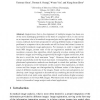Free Online Productivity Tools
i2Speak
i2Symbol
i2OCR
iTex2Img
iWeb2Print
iWeb2Shot
i2Type
iPdf2Split
iPdf2Merge
i2Bopomofo
i2Arabic
i2Style
i2Image
i2PDF
iLatex2Rtf
Sci2ools
126
click to vote
CVBIA
2005
Springer
2005
Springer
A New Coarse-to-Fine Framework for 3D Brain MR Image Registration
Registration, that is, the alignment of multiple images, has been one of the most challenging problems in the field of computer vision. It also serves as an important role in biomedical image analysis and its applications. Although various methods have been proposed for solving different kinds of registration problems in computer vision, the results are still far from ideal when it comes to real world biomedical image applications. For instance, in order to register 3D brain MR images, current state of the art registration methods use a multiresolution coarse-to-fine algorithm, which typically involves starting with low resolution images and working progressively through to higher resolutions, with the aim to avoid the local maximum "traps". However, these methods do not always successfully avoid the local maximum. Consequently, various rather sophisticated optimization methods are developed to attack this problem. In this paper, we propose a novel viewpoint on the coarse-to-...
Related Content
| Added | 26 Jun 2010 |
| Updated | 26 Jun 2010 |
| Type | Conference |
| Year | 2005 |
| Where | CVBIA |
| Authors | Terrence Chen, Thomas S. Huang, Wotao Yin, Xiang Sean Zhou |
Comments (0)

